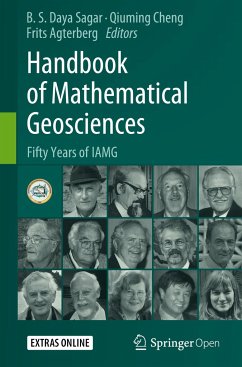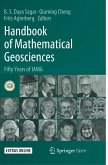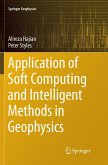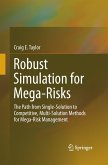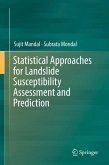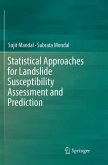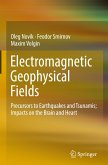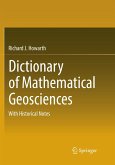Handbook of Mathematical Geosciences
Fifty Years of IAMG
Herausgegeben:Daya Sagar, B. S.; Cheng, Qiuming; Agterberg, Frits
Handbook of Mathematical Geosciences
Fifty Years of IAMG
Herausgegeben:Daya Sagar, B. S.; Cheng, Qiuming; Agterberg, Frits
- Gebundenes Buch
- Merkliste
- Auf die Merkliste
- Bewerten Bewerten
- Teilen
- Produkt teilen
- Produkterinnerung
- Produkterinnerung
This Open Access handbook published at the IAMG's 50th anniversary, presents a compilation of invited path-breaking research contributions by award-winning geoscientists who have been instrumental in shaping the IAMG. It contains 45 chapters that are categorized broadly into five parts (i) theory, (ii) general applications, (iii) exploration and resource estimation, (iv) reviews, and (v) reminiscences covering related topics like mathematical geosciences, mathematical morphology, geostatistics, fractals and multifractals, spatial statistics, multipoint geostatistics, compositional data…mehr
Andere Kunden interessierten sich auch für
![Handbook of Mathematical Geosciences Handbook of Mathematical Geosciences]() Handbook of Mathematical Geosciences42,99 €
Handbook of Mathematical Geosciences42,99 €![Application of Soft Computing and Intelligent Methods in Geophysics Application of Soft Computing and Intelligent Methods in Geophysics]() Alireza HajianApplication of Soft Computing and Intelligent Methods in Geophysics137,99 €
Alireza HajianApplication of Soft Computing and Intelligent Methods in Geophysics137,99 €![Robust Simulation for Mega-Risks Robust Simulation for Mega-Risks]() Craig E. TaylorRobust Simulation for Mega-Risks41,99 €
Craig E. TaylorRobust Simulation for Mega-Risks41,99 €![Statistical Approaches for Landslide Susceptibility Assessment and Prediction Statistical Approaches for Landslide Susceptibility Assessment and Prediction]() Sujit MandalStatistical Approaches for Landslide Susceptibility Assessment and Prediction89,99 €
Sujit MandalStatistical Approaches for Landslide Susceptibility Assessment and Prediction89,99 €![Statistical Approaches for Landslide Susceptibility Assessment and Prediction Statistical Approaches for Landslide Susceptibility Assessment and Prediction]() Sujit MandalStatistical Approaches for Landslide Susceptibility Assessment and Prediction89,99 €
Sujit MandalStatistical Approaches for Landslide Susceptibility Assessment and Prediction89,99 €![Electromagnetic Geophysical Fields Electromagnetic Geophysical Fields]() Oleg NovikElectromagnetic Geophysical Fields81,99 €
Oleg NovikElectromagnetic Geophysical Fields81,99 €![Dictionary of Mathematical Geosciences Dictionary of Mathematical Geosciences]() Richard J. HowarthDictionary of Mathematical Geosciences226,99 €
Richard J. HowarthDictionary of Mathematical Geosciences226,99 €-
-
-
This Open Access handbook published at the IAMG's 50th anniversary, presents a compilation of invited path-breaking research contributions by award-winning geoscientists who have been instrumental in shaping the IAMG. It contains 45 chapters that are categorized broadly into five parts (i) theory, (ii) general applications, (iii) exploration and resource estimation, (iv) reviews, and (v) reminiscences covering related topics like mathematical geosciences, mathematical morphology, geostatistics, fractals and multifractals, spatial statistics, multipoint geostatistics, compositional data analysis, informatics, geocomputation, numerical methods, and chaos theory in the geosciences.
Produktdetails
- Produktdetails
- Verlag: International Association of Mathematical Geosciences (IAMG) / Springer / Springer International Pub
- Artikelnr. des Verlages: 978-3-319-78998-9
- 1st ed. 2018
- Seitenzahl: 944
- Erscheinungstermin: 16. Juli 2018
- Englisch
- Abmessung: 241mm x 160mm x 53mm
- Gewicht: 1688g
- ISBN-13: 9783319789989
- ISBN-10: 3319789988
- Artikelnr.: 51396078
- Herstellerkennzeichnung Die Herstellerinformationen sind derzeit nicht verfügbar.
- Verlag: International Association of Mathematical Geosciences (IAMG) / Springer / Springer International Pub
- Artikelnr. des Verlages: 978-3-319-78998-9
- 1st ed. 2018
- Seitenzahl: 944
- Erscheinungstermin: 16. Juli 2018
- Englisch
- Abmessung: 241mm x 160mm x 53mm
- Gewicht: 1688g
- ISBN-13: 9783319789989
- ISBN-10: 3319789988
- Artikelnr.: 51396078
- Herstellerkennzeichnung Die Herstellerinformationen sind derzeit nicht verfügbar.
B.S. Daya Sagar is a full Professor at the Systems Science and Informatics Unit (SSIU) at the Indian Statistical Institute in Bangalore, India. Dr. Sagar received his MSc and Ph.D. degrees in geoengineering and remote sensing from the Faculty of Engineering, Andhra University, Visakhapatnam, India, in 1991 and 1994 respectively. He is also first Head of the SSIU. Earlier, he worked at the College of Engineering, Andhra University, and Centre for Remote Imaging Sensing and Processing (CRISP), at the The National University of Singapore in various positions during 1992-2001. He served as Associate Professor and Researcher at the Faculty of Engineering & Technology (FET), Multimedia University, Malaysia, during 2001-2007. Since 2017, he has been a Visiting Professor at the University of Trento, Italy. His research interests include mathematical morphology, GISci, digital image processing, fractals and multifractals, their applications in extraction, analyses, and modelling of geophysical patterns. He has published over 85 papers in scientific journals, and has authored and/or guest edited 11 books and/or special theme issues for journals. He recently authored a book entitled "Mathematical Morphology in Geomorphology and GISci". He recently co-edited two special issues on "Filtering and Segmentation with Mathematical Morphology" for IEEE Journal of Selected Topics in Signal Processing and "Applied Earth Observation and Remote Sensing in India" for IEEE Journal of Selected Topics in Applied Earth Observation and Remote Sensing. He is an elected Fellow of Royal Geographical Society (1999), Indian Geophysical Union (2011), and was a member of the New York Academy of Science during 1995-1996. He received the Dr. Balakrishna Memorial Award from the Andhra Pradesh Academy of Sciences in 1995, the Krishnan Gold Medal from the Indian Geophysical Union in 2002, and the "Georges Matheron Award-2011 (with Lecturership)" of the International Association for Mathematical Geosciences. He is the Founding Chairman of Bangalore Section IEEE GRSS Chapter. He is on the Editorial Boards of Computers & Geosciences, and Frontiers: Environmental Informatics. Qiuming Cheng did his Ph.D. in Earth Science under supervision of Dr. Frits Agterberg at the University of Ottawa in 1994. Dr. Cheng spent a year at the Geological Survey of Canada as a PDF under the supervision of Dr. Graeme Bonham-Carter, and soon became a faculty member at York University, Toronto, Canada in 1995 with cross appointments in the Department of Earth and Space Science and Engineering and the Department of Geography. He was promoted to associate professor in 1997 and to full professor in 2002. He was awarded a Changjiang Scholar Professorship in China by the China Ministry of Education where he has set up and leads the State Key Lab of Geological Processes and Mineral Resources (GPMR) located on both campuses of China University of Geosciences in Beijing and Wuhan. Currently, he holds a Thousand Talent National Special Professorship of China, serving as the founding director of the GPMR lab. Dr. Cheng has specialized in mathematical geosciences with a research focus on nonlinear mathematical modelling of earth processes and geoinformatics techniques for prediction of mineral resources. He has authored and coauthored more than 300 research articles. He has been awarded several prestigious awards including the Krumbein Medal, the highest award by the International Association for Mathematical Geosciences (IAMG). Dr. Cheng was an elected President of the International Association for Mathematical Geosciences (IAMG) during 2012-16. He is the president of International Union of Geological Sciences (IUGS) for the period between 2016 and 2020. Dr. Cheng is an international leader in the application of nonlinear mathematics and geoinformatics to the analysis, modelling and prediction of a wide range of geological processes and mineral resources quantitative assessment. Dr. Cheng¿s primary research interest involves the interdisciplinary study of non-linear properties of the Earth¿s systems, as well as quantitative assessment and prediction of natural resources and environmental impacts. His research on fractal density & local singularity analysis theory and geomathematical models has made a major impact in several geoscientific disciplines, including those concerned with ocean ridge heat flow, magmatic flare-up during continent crustal growth and formation of supercontinents, earthquakes, floods, hydrothermal mineralization, and prediction of deeply buried mineral deposits. Frits Agterberg is a Dutch-born Canadian Mathematical Geologist who served at the Geological Survey of Canada in Ottawa. He attended Utrecht University in The Netherlands from 1954 to 1961. With other founding members, he was instrumental in establishing the International Association for Mathematical Geosciences (IAMG) in 1968. He received the IAMG's William Christian Krumbein Medal in 1978 and he was IAMG Distinguished Lecturer in 2004. In 2017 he was conferred with the Honorary Membership of the IAMG. He has authored or coauthored over 250 scientific papers and five books. He has served the IAMG in many ways, including being its President from 2004 to 2008. After defending his doctoral thesis on structural geology of the Italian Alps at Utrecht University and a one-year fellowship at the University of Wisconsin in Madison, he became "petrological statistician" in his first job at the Geological Survey of Canada (GSC) in 1962. He was asked to create the GSC Geomathematics Section in 1971. He retired from the GSC in 1996 but still has an office at their Ottawa headquarters. In 1968, he became associated with the University of Ottawa where he taught a "Statistics in geology" course for 25 years and has supervised six geomathematical PhD students. From 1978 to 1989, he directed the Quantitative Stratigraphy Project of the International Geological Correlation Program. From 1981 to 2001, Dr. Agterberg was a correspondent of the Royal Netherlands Academy of Arts and Sciences. During the past 20 years, primarily in collaboration with Qiuming Cheng, his colleagues and students at the China University of Geosciences in Wuhan and Beijing and at York University, Toronto, he has worked on applications of multifractals to study the spatial distribution of metals in rocks and ore bodies.
ForewordPreface
IntroductionB. S. Daya Sagar, Qiuming Cheng, Frits Agterberg
Part I Theory1.Kriging, Splines, Conditional Simulation, Bayesian In-version and Ensemble Kalman Filtering Olivier Dubrule1.1Introduction1.2Deterministic Aspects of Geostatistics1.3 Stochastic Aspects of Geostatistics: Conditional Simulation1.4Geostatistical Inversion of Seismic Data1.5Kalman Filtering and Ensemble Kalman Filtering1.6Beyond the Formal Relationship between Geostatistics and Bayes 1.7ConclusionReferences
2.A Statistical Commentary on Mineral Prospectivity analysis Adrian Baddeley2.1Introduction2.2Example Data2.3Logistic Regression2.4Poisson Point Process Models2.5Monotone Regression2.6Nonparametric Curve Estimation2.7ROC curves2.8Recursive PartitioningReferences3.Testing joint conditional independence of categorical random variables with a standard log-likelihood ratio test Helmut Schaeben3.1Introduction3.2From Contingency Tables to Log-Linear Models3.3Independence, Conditional Independence of Random variables3.4Logistic Regression, and its Special Case of Weightsof Evidence3.5Hammersley-Clifford Theorem3.6Testing Joint Conditional Independence of Categorical Random Variables3.7Conditional Distribution, Logistic Regression3.8Practical Applications3.9Discussion and ConclusionsReferences
4.Modelling Compositional Data. The Sample Space Ap-proach Juan José Egozcue and Vera Pawlowsky-Glahn4.1Introduction4.2Scale Invariance, Key Principle of Compositions4.3The Simplex as Sample Space of Compositions4.4Perturbation, a Natural Shift Operation on Compositions4.5Conditions on Metrics for Compositions4.6Consequences of the Aitchison Geometry in the Sample Space of Compositional Data4.7ConclusionsReferences
5.Properties of Sums of Geological Random Variables G.M. Kaufman5.1Introduction5.2Preliminaries5.3Thumbnail Case StudiesReferences6.A Statistical Analysis of the Jacobian in Retrievals of Satellite Data Noel Cressie6.1Introduction6.2A Statistical Framework for Satellite Retrievals6.3The Jacobian Matrix and its Unit-Free Version6.4Statistical Significance Filter6.5ACOS Retrievals of the Atmospheric State from Japan's GOSAT Satellite6.6DiscussionReferences
7.All Realizations All the Time Clayton V. Deutsch7.1Introduction7.2Simulation7.3Decision Making7.4Geostatistical Simulation7.5Resource Decision Making7.6Alternatives to All Realizations7.7Concluding RemarksReferences
8.Binary Coefficients Redux Michael E. Hohn8.1Introduction8.2Empirical Comparisons and a Taxonomy8.3Effects of Rare and Endemic Taxa8.4Adjusting for Poor Sampling 8.5Metric? Euclidean?8.6From Expected Values to Null Association8.7Illustrative Example8.8Discussion and Conclusions8.9SummaryReferences
9. Tracking Plurigaussian Simulations M. Armstrong, A. Mondaini and S. Camargo9.1Introduction9.2Review of Complex Networks9.3Network Analysis of Google Citations of Plurigaussian Simulations9.4Diffusion of the New Method into Industry9.5Conclusions and Perspectives for Future WorkReferences
10.Mathematical Geosciences: Local Singularity Analysis of Nonlinear Earth Processes and Extreme Geo-Events Qiuming Cheng10.1Introduction10.2What is Mathematical Geosciences or Geomathematics?10.3What contributions has MG made to geosciences?10.4Frontiers of Earth science and opportunity of MG10.5Fractal density and singularity analysis of nonlinear geo-processes and extreme geo-events 10.6Fractal Integral and fractal differential operations of nonlinear function10.7Earth dynamics processes and extreme events10.8Fractal density of continent rheology in phase transition zones and association with earthquakes 10.9 Discussion and Conclusions References
Part II General Applications11.Electrofacies in Reservoir Characterization John Davis11.1Introduction11.2The Amal Field of Libya11.3Electrofacies Analysis11.4What Do Amal Electrofacies Mean?11.5ConclusionsReferences
12.Forecast of Shoreline Variations by Means of Median Sets Jean Serra12.1Three problems, One Theoretical Tool12.2Median Set12.3Median and Average for Non-Ordered Sets12.4Extrapolations via the Quench Function12.5Accretion and Homotopy12.6ConclusionReferences
13.An Introduction to the Spatio-Temporal Analysis of Sat-ellite Remote Sensing Data for Geostatisticians A. F. Militino, M. D. Ugarte, and U. P´erez-Goya13.1Introduction13.2Satellite Images13.3Derived Variables from Remote Sensing Data13.4Pre-processing13.5Spatial Interpolation13.6Spatio-Temporal Interpolation13.7ConclusionsReferences
14.Flint drinking water crisis: a first attempt to model geo-statistically the space-time distribution of water lead levels Pierre Goovaerts14.1Introduction14.2Materials and Methods14.3Results and Discussion14.4ConclusionsReferences
15.Statistical Parametric Mapping for Geoscience Applica-tions Sean A. McKenna15.1Introduction15.2Anomaly Detection with Statistical Parametric Mapping15.3Example Problems15.4Summary References
16.Water chemistry: are new challenges possible from CoDA (Compositional Data Analysis) point of view? Antonella Buccianti16.1Water Chemistry Data as Compositional Data16.2Isometric-Log Ratio Transformation: Is this the Key to Decipher the Dynamics of Geochemical Systems?16.3Improving CoDA-Dendrogram: Checking for Variability, Resilience and Stability16.4ConclusionsReferences
17.Analysis of the United States Portion of the North Ameri-can Soil Geochemical Landscapes Project - A Composi-tional Framework Approach E. C. Grunsky, L. J. Drew, and D. B. Smith17.1Introduction17.2Methods17.3Results17.4Discussion17.5Concluding RemarksReferencesPart III Exploration and Resource Estimation18.Quantifying the Impacts of Uncertainty Peter Dowd18.1Introduction18.2Sources of In-Situ Uncertainty18.3Transfer Uncertainty18.4Consequences of In-Situ Uncertainty18.5Quantifying Epistemic Uncertainty18.6Quantifying the Effects of Transfer Uncertainty18.7ConclusionReferences
19.Advances in Sensitivity Analysis of Uncertainty due to Sampling Density for Spatially Correlated Attributes Ricardo A. Olea19.1Introduction19.2Data19.3Traditional Uncertainty Assessment19.4Kriging19.5Stochastic Simulation19.6Validation19.7ConclusionsReferences
20.Predicting Molybdenum Deposit Growth John H. Schuenemeyer, Lawrence J. Drew and James D. Bliss20.1Introduction20.2Cutoff Grade as a Function of Deposit Grade20.3 Deposit Growth as a Function of Cutoff Grade20.4 An Example20.5 ConclusionsReferences
21.General Framework of Quantitative Target Selections Guocheng Pan21.1Introduction21.2Randomness of Mineral Endowment21.3Fundamental Geo-Process Relations21.4Scarceness, Rareness, and Exceptionalness21.5Intrinsic Geological Unit21.6Economic Truncation and Translation21.7Information Synthesis21.8Prediction with Dynamic Control SamplesReferences
22.Solving the Wrong Resource Assessment Problems Pre-cisely Donald A. Singer22.1Introduction22.2Target Population22.3Examples of Mismatches in Assessments22.4How to Correct Type III Errors22.5ConclusionsReferences
23.Two ideas for analysis of multivariate geochemical survey data: proximity regression and principal component re-siduals G.F. Bonham-Carter and E. C. Grunsky23.1Introduction23.2Method 1: Direct Prediction of Spatial Proximity23.3Method 2: Principal Component Residuals23.4ConclusionsReferences
24.Mathematical minerals: A history of petrophysical pe-trography John H. Doveton24.1Pioneering Computer Methods24.2Mineralogy of Underdetermined Systems 24.3Mineralogy of Overdetermined Systems24.4Optimization Methods24.5Clay Component Estimation 24.6Normative Estimation by Geochemical Logs24.7ConclusionReferences
25.Geostatistics for Seismic Characterization of Oil Reser-voirs Amílcar Soares and Leonado Azevedo25.1Integration of Geophysical Data for Reservoir Modeling and Characterization25.2Iterative Geostatistical Seismic Inversion Methodologies25.3Trace-by-Trace Geostatistical Seismic Inversion 25.4Global Geostatistical Seismic Inversion Methodologies25.5Uncertainty and Risk Assessment at early stages of exploration25.6Final RemarksReferences
26.Statistical Modeling of Regional and Worldwide Size-Frequency Distributions of Metal Deposits Frits Agterberg26.1Introduction26.2Modified Version of the Model of de Wijs Applied to Worldwide Metal Deposits26.3Theory and Applications of the Pareto-Lognormal Model26.4Upper Tail Pareto Distribution and its Connection to the Basic Lognormal Distribution26.5Prediction of Future Copper Resources26.6Concluding RemarksReferencesPart IV Reviews27.Bayesianism in the Geosciences Jef Caers27.1Introduction27.2A Historical P27.3Science as Knowledge Derived from Facts, Data or Experience27.4The Role of Experiments - Data 27.5Induction vs Deduction27.6Falsificationism27.7Paradigms27.8Bayesianism27.9Bayesianism for Subsurface Systems27.10SummaryReferences
28.Geological Objects and Physical Parameter Fields in the Subsurface: A Review Guillaume Caumon28.1Introduction28.2Motivations for Explicit Geological Parameterizations28.3Parameterizations for Physical Models28.4Geological Parameterizations28.5Conclusions and ChallengesReferences
29.Fifty Years of Kriging Jean-Paul Chilès and Nicolas Desassis29.1Introduction29.2The Origins of Kriging29.3Development and Maturity: Trend, Neighborhood Selection29.4Iterative Use of Kriging to Handle Inequality Data29.5Nonstationary Covariance29.6Kriging for Large Data Sets29.7Iterative Algorithms for Solving the Kriging System29.8ConclusionReferences
30.Multiple Point Statistics: A Review Pejman Tahmasebi30.1Introduction30.2Two-Point based Stochastic Simulation30.3Multiple Point Geostatistics (MPS)30.4Simulation Path30.5Current Multiple Point Geostatistical Algorithms30.6Current ChallengesReferences
31.When Should We Use Multiple-Point Geostatistics? Gregoire Mariethoz31.1Under-Informed vs Over-Informed Models31.2MPS vs Covariance-Based Geostatistics31.3Examples for which MPS Works W31.4ConclusionReferences
32.The Origins of the Multiple-Point Statistics (MPS) Algo-rithm R. Mohan Srivastava32.1Introduction32.21970s 32.31980s32.41990s32.5Concluding ThoughtsReferences
33.Predictive Geometallurgy: An Interdisciplinary Key Challenge for Mathematical Geosciences? K.G. van den Boogaart and R. Tolosana-Delgado33.1Introduction33.2Process Modelling33.3Ore Characterisation33.4Orebody Modelling33.5Decision Making33.6Conclusions References
34.Data Science for Geoscience: Leveraging Mathematical Geosciences with Semantics and Open Data Xiaogang Ma34.1Introduction34.2The Intelligent Stage of Mathematical Geosciences34.3Case Studies of Data Science in Geoscience34.4Concluding RemarksReferences
35.Mathematical Morphology in Geosciences and GISci: An Illustrative Review B. S. Daya Sagar35.1Introduction 35.2Terrestrial Pattern Retrieval35.3Terrestrial Pattern Analysis35.4Geomorphologic Modeling and Simulation35.5Geospatial Computing and Visualization35.6ConclusionsReferences
Part V Reminiscences36.IAMG: Recollections from the Early Years John Cubitt and Stephen Henley, with contributions from T. Victor (Vic) Loudon, EHT (Tim) Whitten, John Gower, Dan-iel (Dan) Merriam, Thomas (Tom) Jones, and Hannes Thiergärtner36.1The Birth of Mathematical Geology and the Origins of the IAMG36.2The Role of the Kansas Geological Survey in the origins of the IAMG36.3Name and Establishment of the Society36.4Foundation of IAMG Publications36.5Prague36.6Subsequent Events following Prague - 36.7The Looming Gap References
37.Forward and Inverse Models over 70 Years E. H. Timothy Whitten 37.1Birth of IAMG in 196837.2In the Beginning (one pre-1968 experience)37.3Inverse and Forward Geology Problems37.4Forward Models in Earth Sciences37.5Inverse Models in Earth Sciences37.6The Samples Analysed37.7The Black Swan Effect37.8Concluding ThoughtsReferences
38.From individual personal contacts 1962-1968 to my 50 years of service Václav Nemec 38.1Introduction38.2IAMG Foundation (Prague 1968)38.3Activities for the IAMG 1968 - 199338.4Príbram - East - West Gate near the Iron Curtain38.5My own professional work38.6Two Separate Silver Anniversary Meetings of Mathematical Geologists in Prague (1993)38.7From the Silver to the Golden IAMG Jubilee 38.9ConclusionReferences
39.Andrey Borisovich Vistelius Stephen Henley39.1Background39.2Scientific Achievements and Insights39.3The International Association for Mathematical Geology39.4The "Father of Mathematical Geology"?39.5LegacyReferences
40.Fifty Years' Experience with Hidden Errors in Applying Classic Mathematical Geology Hannes Thiergärtner40.1Introduction and Definitions40.2Hidden errors and Case Study Examples40.3Conclusion and SuggestionsReferences
41.Mathematical Geology by Example: Teaching and Learning Perspectives James R. Carr41.1Introduction41.2Multivariate Analysis of Geochemical Data41.3Geostatistics and its Myriad Parameters41.4 The Variogram as a Stand-Alone Data Analytical ToolReferences
42.Linear Unmixing in the Geologic Sciences: More Than a Half of Century of Progress William E. Full42.1Introduction42.2History of Constant Sum HVA42.3Non-Constant Sum Data and Algorithms42.4SummaryReferences
43.Pearce Element Ratio Diagrams and Cumulate Rocks James Nicholls43.1Introduction43.2Outline of a Cumulate Rock Paradigm43.3Pearce Element Ratio Patterns for Cumulate Rocks43.4Compositions of Units of the Skaergaard Intrusion43.5Melts of the Skaergaard Intrusion43.6Pearce Element Ratios, Cumulate Rocks, and September 11References
44.Reflections on the Name of IAMG and of the Journal Donald E. Myers
45.Origin and Early Development of the IAMG Frits Agterberg45.1Introduction45.2Pioneers of Mathematical Geology45.3Inputs from Mathematical Statisticians45.4Concluding RemarksReferences
IntroductionB. S. Daya Sagar, Qiuming Cheng, Frits Agterberg
Part I Theory1.Kriging, Splines, Conditional Simulation, Bayesian In-version and Ensemble Kalman Filtering Olivier Dubrule1.1Introduction1.2Deterministic Aspects of Geostatistics1.3 Stochastic Aspects of Geostatistics: Conditional Simulation1.4Geostatistical Inversion of Seismic Data1.5Kalman Filtering and Ensemble Kalman Filtering1.6Beyond the Formal Relationship between Geostatistics and Bayes 1.7ConclusionReferences
2.A Statistical Commentary on Mineral Prospectivity analysis Adrian Baddeley2.1Introduction2.2Example Data2.3Logistic Regression2.4Poisson Point Process Models2.5Monotone Regression2.6Nonparametric Curve Estimation2.7ROC curves2.8Recursive PartitioningReferences3.Testing joint conditional independence of categorical random variables with a standard log-likelihood ratio test Helmut Schaeben3.1Introduction3.2From Contingency Tables to Log-Linear Models3.3Independence, Conditional Independence of Random variables3.4Logistic Regression, and its Special Case of Weightsof Evidence3.5Hammersley-Clifford Theorem3.6Testing Joint Conditional Independence of Categorical Random Variables3.7Conditional Distribution, Logistic Regression3.8Practical Applications3.9Discussion and ConclusionsReferences
4.Modelling Compositional Data. The Sample Space Ap-proach Juan José Egozcue and Vera Pawlowsky-Glahn4.1Introduction4.2Scale Invariance, Key Principle of Compositions4.3The Simplex as Sample Space of Compositions4.4Perturbation, a Natural Shift Operation on Compositions4.5Conditions on Metrics for Compositions4.6Consequences of the Aitchison Geometry in the Sample Space of Compositional Data4.7ConclusionsReferences
5.Properties of Sums of Geological Random Variables G.M. Kaufman5.1Introduction5.2Preliminaries5.3Thumbnail Case StudiesReferences6.A Statistical Analysis of the Jacobian in Retrievals of Satellite Data Noel Cressie6.1Introduction6.2A Statistical Framework for Satellite Retrievals6.3The Jacobian Matrix and its Unit-Free Version6.4Statistical Significance Filter6.5ACOS Retrievals of the Atmospheric State from Japan's GOSAT Satellite6.6DiscussionReferences
7.All Realizations All the Time Clayton V. Deutsch7.1Introduction7.2Simulation7.3Decision Making7.4Geostatistical Simulation7.5Resource Decision Making7.6Alternatives to All Realizations7.7Concluding RemarksReferences
8.Binary Coefficients Redux Michael E. Hohn8.1Introduction8.2Empirical Comparisons and a Taxonomy8.3Effects of Rare and Endemic Taxa8.4Adjusting for Poor Sampling 8.5Metric? Euclidean?8.6From Expected Values to Null Association8.7Illustrative Example8.8Discussion and Conclusions8.9SummaryReferences
9. Tracking Plurigaussian Simulations M. Armstrong, A. Mondaini and S. Camargo9.1Introduction9.2Review of Complex Networks9.3Network Analysis of Google Citations of Plurigaussian Simulations9.4Diffusion of the New Method into Industry9.5Conclusions and Perspectives for Future WorkReferences
10.Mathematical Geosciences: Local Singularity Analysis of Nonlinear Earth Processes and Extreme Geo-Events Qiuming Cheng10.1Introduction10.2What is Mathematical Geosciences or Geomathematics?10.3What contributions has MG made to geosciences?10.4Frontiers of Earth science and opportunity of MG10.5Fractal density and singularity analysis of nonlinear geo-processes and extreme geo-events 10.6Fractal Integral and fractal differential operations of nonlinear function10.7Earth dynamics processes and extreme events10.8Fractal density of continent rheology in phase transition zones and association with earthquakes 10.9 Discussion and Conclusions References
Part II General Applications11.Electrofacies in Reservoir Characterization John Davis11.1Introduction11.2The Amal Field of Libya11.3Electrofacies Analysis11.4What Do Amal Electrofacies Mean?11.5ConclusionsReferences
12.Forecast of Shoreline Variations by Means of Median Sets Jean Serra12.1Three problems, One Theoretical Tool12.2Median Set12.3Median and Average for Non-Ordered Sets12.4Extrapolations via the Quench Function12.5Accretion and Homotopy12.6ConclusionReferences
13.An Introduction to the Spatio-Temporal Analysis of Sat-ellite Remote Sensing Data for Geostatisticians A. F. Militino, M. D. Ugarte, and U. P´erez-Goya13.1Introduction13.2Satellite Images13.3Derived Variables from Remote Sensing Data13.4Pre-processing13.5Spatial Interpolation13.6Spatio-Temporal Interpolation13.7ConclusionsReferences
14.Flint drinking water crisis: a first attempt to model geo-statistically the space-time distribution of water lead levels Pierre Goovaerts14.1Introduction14.2Materials and Methods14.3Results and Discussion14.4ConclusionsReferences
15.Statistical Parametric Mapping for Geoscience Applica-tions Sean A. McKenna15.1Introduction15.2Anomaly Detection with Statistical Parametric Mapping15.3Example Problems15.4Summary References
16.Water chemistry: are new challenges possible from CoDA (Compositional Data Analysis) point of view? Antonella Buccianti16.1Water Chemistry Data as Compositional Data16.2Isometric-Log Ratio Transformation: Is this the Key to Decipher the Dynamics of Geochemical Systems?16.3Improving CoDA-Dendrogram: Checking for Variability, Resilience and Stability16.4ConclusionsReferences
17.Analysis of the United States Portion of the North Ameri-can Soil Geochemical Landscapes Project - A Composi-tional Framework Approach E. C. Grunsky, L. J. Drew, and D. B. Smith17.1Introduction17.2Methods17.3Results17.4Discussion17.5Concluding RemarksReferencesPart III Exploration and Resource Estimation18.Quantifying the Impacts of Uncertainty Peter Dowd18.1Introduction18.2Sources of In-Situ Uncertainty18.3Transfer Uncertainty18.4Consequences of In-Situ Uncertainty18.5Quantifying Epistemic Uncertainty18.6Quantifying the Effects of Transfer Uncertainty18.7ConclusionReferences
19.Advances in Sensitivity Analysis of Uncertainty due to Sampling Density for Spatially Correlated Attributes Ricardo A. Olea19.1Introduction19.2Data19.3Traditional Uncertainty Assessment19.4Kriging19.5Stochastic Simulation19.6Validation19.7ConclusionsReferences
20.Predicting Molybdenum Deposit Growth John H. Schuenemeyer, Lawrence J. Drew and James D. Bliss20.1Introduction20.2Cutoff Grade as a Function of Deposit Grade20.3 Deposit Growth as a Function of Cutoff Grade20.4 An Example20.5 ConclusionsReferences
21.General Framework of Quantitative Target Selections Guocheng Pan21.1Introduction21.2Randomness of Mineral Endowment21.3Fundamental Geo-Process Relations21.4Scarceness, Rareness, and Exceptionalness21.5Intrinsic Geological Unit21.6Economic Truncation and Translation21.7Information Synthesis21.8Prediction with Dynamic Control SamplesReferences
22.Solving the Wrong Resource Assessment Problems Pre-cisely Donald A. Singer22.1Introduction22.2Target Population22.3Examples of Mismatches in Assessments22.4How to Correct Type III Errors22.5ConclusionsReferences
23.Two ideas for analysis of multivariate geochemical survey data: proximity regression and principal component re-siduals G.F. Bonham-Carter and E. C. Grunsky23.1Introduction23.2Method 1: Direct Prediction of Spatial Proximity23.3Method 2: Principal Component Residuals23.4ConclusionsReferences
24.Mathematical minerals: A history of petrophysical pe-trography John H. Doveton24.1Pioneering Computer Methods24.2Mineralogy of Underdetermined Systems 24.3Mineralogy of Overdetermined Systems24.4Optimization Methods24.5Clay Component Estimation 24.6Normative Estimation by Geochemical Logs24.7ConclusionReferences
25.Geostatistics for Seismic Characterization of Oil Reser-voirs Amílcar Soares and Leonado Azevedo25.1Integration of Geophysical Data for Reservoir Modeling and Characterization25.2Iterative Geostatistical Seismic Inversion Methodologies25.3Trace-by-Trace Geostatistical Seismic Inversion 25.4Global Geostatistical Seismic Inversion Methodologies25.5Uncertainty and Risk Assessment at early stages of exploration25.6Final RemarksReferences
26.Statistical Modeling of Regional and Worldwide Size-Frequency Distributions of Metal Deposits Frits Agterberg26.1Introduction26.2Modified Version of the Model of de Wijs Applied to Worldwide Metal Deposits26.3Theory and Applications of the Pareto-Lognormal Model26.4Upper Tail Pareto Distribution and its Connection to the Basic Lognormal Distribution26.5Prediction of Future Copper Resources26.6Concluding RemarksReferencesPart IV Reviews27.Bayesianism in the Geosciences Jef Caers27.1Introduction27.2A Historical P27.3Science as Knowledge Derived from Facts, Data or Experience27.4The Role of Experiments - Data 27.5Induction vs Deduction27.6Falsificationism27.7Paradigms27.8Bayesianism27.9Bayesianism for Subsurface Systems27.10SummaryReferences
28.Geological Objects and Physical Parameter Fields in the Subsurface: A Review Guillaume Caumon28.1Introduction28.2Motivations for Explicit Geological Parameterizations28.3Parameterizations for Physical Models28.4Geological Parameterizations28.5Conclusions and ChallengesReferences
29.Fifty Years of Kriging Jean-Paul Chilès and Nicolas Desassis29.1Introduction29.2The Origins of Kriging29.3Development and Maturity: Trend, Neighborhood Selection29.4Iterative Use of Kriging to Handle Inequality Data29.5Nonstationary Covariance29.6Kriging for Large Data Sets29.7Iterative Algorithms for Solving the Kriging System29.8ConclusionReferences
30.Multiple Point Statistics: A Review Pejman Tahmasebi30.1Introduction30.2Two-Point based Stochastic Simulation30.3Multiple Point Geostatistics (MPS)30.4Simulation Path30.5Current Multiple Point Geostatistical Algorithms30.6Current ChallengesReferences
31.When Should We Use Multiple-Point Geostatistics? Gregoire Mariethoz31.1Under-Informed vs Over-Informed Models31.2MPS vs Covariance-Based Geostatistics31.3Examples for which MPS Works W31.4ConclusionReferences
32.The Origins of the Multiple-Point Statistics (MPS) Algo-rithm R. Mohan Srivastava32.1Introduction32.21970s 32.31980s32.41990s32.5Concluding ThoughtsReferences
33.Predictive Geometallurgy: An Interdisciplinary Key Challenge for Mathematical Geosciences? K.G. van den Boogaart and R. Tolosana-Delgado33.1Introduction33.2Process Modelling33.3Ore Characterisation33.4Orebody Modelling33.5Decision Making33.6Conclusions References
34.Data Science for Geoscience: Leveraging Mathematical Geosciences with Semantics and Open Data Xiaogang Ma34.1Introduction34.2The Intelligent Stage of Mathematical Geosciences34.3Case Studies of Data Science in Geoscience34.4Concluding RemarksReferences
35.Mathematical Morphology in Geosciences and GISci: An Illustrative Review B. S. Daya Sagar35.1Introduction 35.2Terrestrial Pattern Retrieval35.3Terrestrial Pattern Analysis35.4Geomorphologic Modeling and Simulation35.5Geospatial Computing and Visualization35.6ConclusionsReferences
Part V Reminiscences36.IAMG: Recollections from the Early Years John Cubitt and Stephen Henley, with contributions from T. Victor (Vic) Loudon, EHT (Tim) Whitten, John Gower, Dan-iel (Dan) Merriam, Thomas (Tom) Jones, and Hannes Thiergärtner36.1The Birth of Mathematical Geology and the Origins of the IAMG36.2The Role of the Kansas Geological Survey in the origins of the IAMG36.3Name and Establishment of the Society36.4Foundation of IAMG Publications36.5Prague36.6Subsequent Events following Prague - 36.7The Looming Gap References
37.Forward and Inverse Models over 70 Years E. H. Timothy Whitten 37.1Birth of IAMG in 196837.2In the Beginning (one pre-1968 experience)37.3Inverse and Forward Geology Problems37.4Forward Models in Earth Sciences37.5Inverse Models in Earth Sciences37.6The Samples Analysed37.7The Black Swan Effect37.8Concluding ThoughtsReferences
38.From individual personal contacts 1962-1968 to my 50 years of service Václav Nemec 38.1Introduction38.2IAMG Foundation (Prague 1968)38.3Activities for the IAMG 1968 - 199338.4Príbram - East - West Gate near the Iron Curtain38.5My own professional work38.6Two Separate Silver Anniversary Meetings of Mathematical Geologists in Prague (1993)38.7From the Silver to the Golden IAMG Jubilee 38.9ConclusionReferences
39.Andrey Borisovich Vistelius Stephen Henley39.1Background39.2Scientific Achievements and Insights39.3The International Association for Mathematical Geology39.4The "Father of Mathematical Geology"?39.5LegacyReferences
40.Fifty Years' Experience with Hidden Errors in Applying Classic Mathematical Geology Hannes Thiergärtner40.1Introduction and Definitions40.2Hidden errors and Case Study Examples40.3Conclusion and SuggestionsReferences
41.Mathematical Geology by Example: Teaching and Learning Perspectives James R. Carr41.1Introduction41.2Multivariate Analysis of Geochemical Data41.3Geostatistics and its Myriad Parameters41.4 The Variogram as a Stand-Alone Data Analytical ToolReferences
42.Linear Unmixing in the Geologic Sciences: More Than a Half of Century of Progress William E. Full42.1Introduction42.2History of Constant Sum HVA42.3Non-Constant Sum Data and Algorithms42.4SummaryReferences
43.Pearce Element Ratio Diagrams and Cumulate Rocks James Nicholls43.1Introduction43.2Outline of a Cumulate Rock Paradigm43.3Pearce Element Ratio Patterns for Cumulate Rocks43.4Compositions of Units of the Skaergaard Intrusion43.5Melts of the Skaergaard Intrusion43.6Pearce Element Ratios, Cumulate Rocks, and September 11References
44.Reflections on the Name of IAMG and of the Journal Donald E. Myers
45.Origin and Early Development of the IAMG Frits Agterberg45.1Introduction45.2Pioneers of Mathematical Geology45.3Inputs from Mathematical Statisticians45.4Concluding RemarksReferences
ForewordPreface
IntroductionB. S. Daya Sagar, Qiuming Cheng, Frits Agterberg
Part I Theory1.Kriging, Splines, Conditional Simulation, Bayesian In-version and Ensemble Kalman Filtering Olivier Dubrule1.1Introduction1.2Deterministic Aspects of Geostatistics1.3 Stochastic Aspects of Geostatistics: Conditional Simulation1.4Geostatistical Inversion of Seismic Data1.5Kalman Filtering and Ensemble Kalman Filtering1.6Beyond the Formal Relationship between Geostatistics and Bayes 1.7ConclusionReferences
2.A Statistical Commentary on Mineral Prospectivity analysis Adrian Baddeley2.1Introduction2.2Example Data2.3Logistic Regression2.4Poisson Point Process Models2.5Monotone Regression2.6Nonparametric Curve Estimation2.7ROC curves2.8Recursive PartitioningReferences3.Testing joint conditional independence of categorical random variables with a standard log-likelihood ratio test Helmut Schaeben3.1Introduction3.2From Contingency Tables to Log-Linear Models3.3Independence, Conditional Independence of Random variables3.4Logistic Regression, and its Special Case of Weightsof Evidence3.5Hammersley-Clifford Theorem3.6Testing Joint Conditional Independence of Categorical Random Variables3.7Conditional Distribution, Logistic Regression3.8Practical Applications3.9Discussion and ConclusionsReferences
4.Modelling Compositional Data. The Sample Space Ap-proach Juan José Egozcue and Vera Pawlowsky-Glahn4.1Introduction4.2Scale Invariance, Key Principle of Compositions4.3The Simplex as Sample Space of Compositions4.4Perturbation, a Natural Shift Operation on Compositions4.5Conditions on Metrics for Compositions4.6Consequences of the Aitchison Geometry in the Sample Space of Compositional Data4.7ConclusionsReferences
5.Properties of Sums of Geological Random Variables G.M. Kaufman5.1Introduction5.2Preliminaries5.3Thumbnail Case StudiesReferences6.A Statistical Analysis of the Jacobian in Retrievals of Satellite Data Noel Cressie6.1Introduction6.2A Statistical Framework for Satellite Retrievals6.3The Jacobian Matrix and its Unit-Free Version6.4Statistical Significance Filter6.5ACOS Retrievals of the Atmospheric State from Japan's GOSAT Satellite6.6DiscussionReferences
7.All Realizations All the Time Clayton V. Deutsch7.1Introduction7.2Simulation7.3Decision Making7.4Geostatistical Simulation7.5Resource Decision Making7.6Alternatives to All Realizations7.7Concluding RemarksReferences
8.Binary Coefficients Redux Michael E. Hohn8.1Introduction8.2Empirical Comparisons and a Taxonomy8.3Effects of Rare and Endemic Taxa8.4Adjusting for Poor Sampling 8.5Metric? Euclidean?8.6From Expected Values to Null Association8.7Illustrative Example8.8Discussion and Conclusions8.9SummaryReferences
9. Tracking Plurigaussian Simulations M. Armstrong, A. Mondaini and S. Camargo9.1Introduction9.2Review of Complex Networks9.3Network Analysis of Google Citations of Plurigaussian Simulations9.4Diffusion of the New Method into Industry9.5Conclusions and Perspectives for Future WorkReferences
10.Mathematical Geosciences: Local Singularity Analysis of Nonlinear Earth Processes and Extreme Geo-Events Qiuming Cheng10.1Introduction10.2What is Mathematical Geosciences or Geomathematics?10.3What contributions has MG made to geosciences?10.4Frontiers of Earth science and opportunity of MG10.5Fractal density and singularity analysis of nonlinear geo-processes and extreme geo-events 10.6Fractal Integral and fractal differential operations of nonlinear function10.7Earth dynamics processes and extreme events10.8Fractal density of continent rheology in phase transition zones and association with earthquakes 10.9 Discussion and Conclusions References
Part II General Applications11.Electrofacies in Reservoir Characterization John Davis11.1Introduction11.2The Amal Field of Libya11.3Electrofacies Analysis11.4What Do Amal Electrofacies Mean?11.5ConclusionsReferences
12.Forecast of Shoreline Variations by Means of Median Sets Jean Serra12.1Three problems, One Theoretical Tool12.2Median Set12.3Median and Average for Non-Ordered Sets12.4Extrapolations via the Quench Function12.5Accretion and Homotopy12.6ConclusionReferences
13.An Introduction to the Spatio-Temporal Analysis of Sat-ellite Remote Sensing Data for Geostatisticians A. F. Militino, M. D. Ugarte, and U. P´erez-Goya13.1Introduction13.2Satellite Images13.3Derived Variables from Remote Sensing Data13.4Pre-processing13.5Spatial Interpolation13.6Spatio-Temporal Interpolation13.7ConclusionsReferences
14.Flint drinking water crisis: a first attempt to model geo-statistically the space-time distribution of water lead levels Pierre Goovaerts14.1Introduction14.2Materials and Methods14.3Results and Discussion14.4ConclusionsReferences
15.Statistical Parametric Mapping for Geoscience Applica-tions Sean A. McKenna15.1Introduction15.2Anomaly Detection with Statistical Parametric Mapping15.3Example Problems15.4Summary References
16.Water chemistry: are new challenges possible from CoDA (Compositional Data Analysis) point of view? Antonella Buccianti16.1Water Chemistry Data as Compositional Data16.2Isometric-Log Ratio Transformation: Is this the Key to Decipher the Dynamics of Geochemical Systems?16.3Improving CoDA-Dendrogram: Checking for Variability, Resilience and Stability16.4ConclusionsReferences
17.Analysis of the United States Portion of the North Ameri-can Soil Geochemical Landscapes Project - A Composi-tional Framework Approach E. C. Grunsky, L. J. Drew, and D. B. Smith17.1Introduction17.2Methods17.3Results17.4Discussion17.5Concluding RemarksReferencesPart III Exploration and Resource Estimation18.Quantifying the Impacts of Uncertainty Peter Dowd18.1Introduction18.2Sources of In-Situ Uncertainty18.3Transfer Uncertainty18.4Consequences of In-Situ Uncertainty18.5Quantifying Epistemic Uncertainty18.6Quantifying the Effects of Transfer Uncertainty18.7ConclusionReferences
19.Advances in Sensitivity Analysis of Uncertainty due to Sampling Density for Spatially Correlated Attributes Ricardo A. Olea19.1Introduction19.2Data19.3Traditional Uncertainty Assessment19.4Kriging19.5Stochastic Simulation19.6Validation19.7ConclusionsReferences
20.Predicting Molybdenum Deposit Growth John H. Schuenemeyer, Lawrence J. Drew and James D. Bliss20.1Introduction20.2Cutoff Grade as a Function of Deposit Grade20.3 Deposit Growth as a Function of Cutoff Grade20.4 An Example20.5 ConclusionsReferences
21.General Framework of Quantitative Target Selections Guocheng Pan21.1Introduction21.2Randomness of Mineral Endowment21.3Fundamental Geo-Process Relations21.4Scarceness, Rareness, and Exceptionalness21.5Intrinsic Geological Unit21.6Economic Truncation and Translation21.7Information Synthesis21.8Prediction with Dynamic Control SamplesReferences
22.Solving the Wrong Resource Assessment Problems Pre-cisely Donald A. Singer22.1Introduction22.2Target Population22.3Examples of Mismatches in Assessments22.4How to Correct Type III Errors22.5ConclusionsReferences
23.Two ideas for analysis of multivariate geochemical survey data: proximity regression and principal component re-siduals G.F. Bonham-Carter and E. C. Grunsky23.1Introduction23.2Method 1: Direct Prediction of Spatial Proximity23.3Method 2: Principal Component Residuals23.4ConclusionsReferences
24.Mathematical minerals: A history of petrophysical pe-trography John H. Doveton24.1Pioneering Computer Methods24.2Mineralogy of Underdetermined Systems 24.3Mineralogy of Overdetermined Systems24.4Optimization Methods24.5Clay Component Estimation 24.6Normative Estimation by Geochemical Logs24.7ConclusionReferences
25.Geostatistics for Seismic Characterization of Oil Reser-voirs Amílcar Soares and Leonado Azevedo25.1Integration of Geophysical Data for Reservoir Modeling and Characterization25.2Iterative Geostatistical Seismic Inversion Methodologies25.3Trace-by-Trace Geostatistical Seismic Inversion 25.4Global Geostatistical Seismic Inversion Methodologies25.5Uncertainty and Risk Assessment at early stages of exploration25.6Final RemarksReferences
26.Statistical Modeling of Regional and Worldwide Size-Frequency Distributions of Metal Deposits Frits Agterberg26.1Introduction26.2Modified Version of the Model of de Wijs Applied to Worldwide Metal Deposits26.3Theory and Applications of the Pareto-Lognormal Model26.4Upper Tail Pareto Distribution and its Connection to the Basic Lognormal Distribution26.5Prediction of Future Copper Resources26.6Concluding RemarksReferencesPart IV Reviews27.Bayesianism in the Geosciences Jef Caers27.1Introduction27.2A Historical P27.3Science as Knowledge Derived from Facts, Data or Experience27.4The Role of Experiments - Data 27.5Induction vs Deduction27.6Falsificationism27.7Paradigms27.8Bayesianism27.9Bayesianism for Subsurface Systems27.10SummaryReferences
28.Geological Objects and Physical Parameter Fields in the Subsurface: A Review Guillaume Caumon28.1Introduction28.2Motivations for Explicit Geological Parameterizations28.3Parameterizations for Physical Models28.4Geological Parameterizations28.5Conclusions and ChallengesReferences
29.Fifty Years of Kriging Jean-Paul Chilès and Nicolas Desassis29.1Introduction29.2The Origins of Kriging29.3Development and Maturity: Trend, Neighborhood Selection29.4Iterative Use of Kriging to Handle Inequality Data29.5Nonstationary Covariance29.6Kriging for Large Data Sets29.7Iterative Algorithms for Solving the Kriging System29.8ConclusionReferences
30.Multiple Point Statistics: A Review Pejman Tahmasebi30.1Introduction30.2Two-Point based Stochastic Simulation30.3Multiple Point Geostatistics (MPS)30.4Simulation Path30.5Current Multiple Point Geostatistical Algorithms30.6Current ChallengesReferences
31.When Should We Use Multiple-Point Geostatistics? Gregoire Mariethoz31.1Under-Informed vs Over-Informed Models31.2MPS vs Covariance-Based Geostatistics31.3Examples for which MPS Works W31.4ConclusionReferences
32.The Origins of the Multiple-Point Statistics (MPS) Algo-rithm R. Mohan Srivastava32.1Introduction32.21970s 32.31980s32.41990s32.5Concluding ThoughtsReferences
33.Predictive Geometallurgy: An Interdisciplinary Key Challenge for Mathematical Geosciences? K.G. van den Boogaart and R. Tolosana-Delgado33.1Introduction33.2Process Modelling33.3Ore Characterisation33.4Orebody Modelling33.5Decision Making33.6Conclusions References
34.Data Science for Geoscience: Leveraging Mathematical Geosciences with Semantics and Open Data Xiaogang Ma34.1Introduction34.2The Intelligent Stage of Mathematical Geosciences34.3Case Studies of Data Science in Geoscience34.4Concluding RemarksReferences
35.Mathematical Morphology in Geosciences and GISci: An Illustrative Review B. S. Daya Sagar35.1Introduction 35.2Terrestrial Pattern Retrieval35.3Terrestrial Pattern Analysis35.4Geomorphologic Modeling and Simulation35.5Geospatial Computing and Visualization35.6ConclusionsReferences
Part V Reminiscences36.IAMG: Recollections from the Early Years John Cubitt and Stephen Henley, with contributions from T. Victor (Vic) Loudon, EHT (Tim) Whitten, John Gower, Dan-iel (Dan) Merriam, Thomas (Tom) Jones, and Hannes Thiergärtner36.1The Birth of Mathematical Geology and the Origins of the IAMG36.2The Role of the Kansas Geological Survey in the origins of the IAMG36.3Name and Establishment of the Society36.4Foundation of IAMG Publications36.5Prague36.6Subsequent Events following Prague - 36.7The Looming Gap References
37.Forward and Inverse Models over 70 Years E. H. Timothy Whitten 37.1Birth of IAMG in 196837.2In the Beginning (one pre-1968 experience)37.3Inverse and Forward Geology Problems37.4Forward Models in Earth Sciences37.5Inverse Models in Earth Sciences37.6The Samples Analysed37.7The Black Swan Effect37.8Concluding ThoughtsReferences
38.From individual personal contacts 1962-1968 to my 50 years of service Václav Nemec 38.1Introduction38.2IAMG Foundation (Prague 1968)38.3Activities for the IAMG 1968 - 199338.4Príbram - East - West Gate near the Iron Curtain38.5My own professional work38.6Two Separate Silver Anniversary Meetings of Mathematical Geologists in Prague (1993)38.7From the Silver to the Golden IAMG Jubilee 38.9ConclusionReferences
39.Andrey Borisovich Vistelius Stephen Henley39.1Background39.2Scientific Achievements and Insights39.3The International Association for Mathematical Geology39.4The "Father of Mathematical Geology"?39.5LegacyReferences
40.Fifty Years' Experience with Hidden Errors in Applying Classic Mathematical Geology Hannes Thiergärtner40.1Introduction and Definitions40.2Hidden errors and Case Study Examples40.3Conclusion and SuggestionsReferences
41.Mathematical Geology by Example: Teaching and Learning Perspectives James R. Carr41.1Introduction41.2Multivariate Analysis of Geochemical Data41.3Geostatistics and its Myriad Parameters41.4 The Variogram as a Stand-Alone Data Analytical ToolReferences
42.Linear Unmixing in the Geologic Sciences: More Than a Half of Century of Progress William E. Full42.1Introduction42.2History of Constant Sum HVA42.3Non-Constant Sum Data and Algorithms42.4SummaryReferences
43.Pearce Element Ratio Diagrams and Cumulate Rocks James Nicholls43.1Introduction43.2Outline of a Cumulate Rock Paradigm43.3Pearce Element Ratio Patterns for Cumulate Rocks43.4Compositions of Units of the Skaergaard Intrusion43.5Melts of the Skaergaard Intrusion43.6Pearce Element Ratios, Cumulate Rocks, and September 11References
44.Reflections on the Name of IAMG and of the Journal Donald E. Myers
45.Origin and Early Development of the IAMG Frits Agterberg45.1Introduction45.2Pioneers of Mathematical Geology45.3Inputs from Mathematical Statisticians45.4Concluding RemarksReferences
IntroductionB. S. Daya Sagar, Qiuming Cheng, Frits Agterberg
Part I Theory1.Kriging, Splines, Conditional Simulation, Bayesian In-version and Ensemble Kalman Filtering Olivier Dubrule1.1Introduction1.2Deterministic Aspects of Geostatistics1.3 Stochastic Aspects of Geostatistics: Conditional Simulation1.4Geostatistical Inversion of Seismic Data1.5Kalman Filtering and Ensemble Kalman Filtering1.6Beyond the Formal Relationship between Geostatistics and Bayes 1.7ConclusionReferences
2.A Statistical Commentary on Mineral Prospectivity analysis Adrian Baddeley2.1Introduction2.2Example Data2.3Logistic Regression2.4Poisson Point Process Models2.5Monotone Regression2.6Nonparametric Curve Estimation2.7ROC curves2.8Recursive PartitioningReferences3.Testing joint conditional independence of categorical random variables with a standard log-likelihood ratio test Helmut Schaeben3.1Introduction3.2From Contingency Tables to Log-Linear Models3.3Independence, Conditional Independence of Random variables3.4Logistic Regression, and its Special Case of Weightsof Evidence3.5Hammersley-Clifford Theorem3.6Testing Joint Conditional Independence of Categorical Random Variables3.7Conditional Distribution, Logistic Regression3.8Practical Applications3.9Discussion and ConclusionsReferences
4.Modelling Compositional Data. The Sample Space Ap-proach Juan José Egozcue and Vera Pawlowsky-Glahn4.1Introduction4.2Scale Invariance, Key Principle of Compositions4.3The Simplex as Sample Space of Compositions4.4Perturbation, a Natural Shift Operation on Compositions4.5Conditions on Metrics for Compositions4.6Consequences of the Aitchison Geometry in the Sample Space of Compositional Data4.7ConclusionsReferences
5.Properties of Sums of Geological Random Variables G.M. Kaufman5.1Introduction5.2Preliminaries5.3Thumbnail Case StudiesReferences6.A Statistical Analysis of the Jacobian in Retrievals of Satellite Data Noel Cressie6.1Introduction6.2A Statistical Framework for Satellite Retrievals6.3The Jacobian Matrix and its Unit-Free Version6.4Statistical Significance Filter6.5ACOS Retrievals of the Atmospheric State from Japan's GOSAT Satellite6.6DiscussionReferences
7.All Realizations All the Time Clayton V. Deutsch7.1Introduction7.2Simulation7.3Decision Making7.4Geostatistical Simulation7.5Resource Decision Making7.6Alternatives to All Realizations7.7Concluding RemarksReferences
8.Binary Coefficients Redux Michael E. Hohn8.1Introduction8.2Empirical Comparisons and a Taxonomy8.3Effects of Rare and Endemic Taxa8.4Adjusting for Poor Sampling 8.5Metric? Euclidean?8.6From Expected Values to Null Association8.7Illustrative Example8.8Discussion and Conclusions8.9SummaryReferences
9. Tracking Plurigaussian Simulations M. Armstrong, A. Mondaini and S. Camargo9.1Introduction9.2Review of Complex Networks9.3Network Analysis of Google Citations of Plurigaussian Simulations9.4Diffusion of the New Method into Industry9.5Conclusions and Perspectives for Future WorkReferences
10.Mathematical Geosciences: Local Singularity Analysis of Nonlinear Earth Processes and Extreme Geo-Events Qiuming Cheng10.1Introduction10.2What is Mathematical Geosciences or Geomathematics?10.3What contributions has MG made to geosciences?10.4Frontiers of Earth science and opportunity of MG10.5Fractal density and singularity analysis of nonlinear geo-processes and extreme geo-events 10.6Fractal Integral and fractal differential operations of nonlinear function10.7Earth dynamics processes and extreme events10.8Fractal density of continent rheology in phase transition zones and association with earthquakes 10.9 Discussion and Conclusions References
Part II General Applications11.Electrofacies in Reservoir Characterization John Davis11.1Introduction11.2The Amal Field of Libya11.3Electrofacies Analysis11.4What Do Amal Electrofacies Mean?11.5ConclusionsReferences
12.Forecast of Shoreline Variations by Means of Median Sets Jean Serra12.1Three problems, One Theoretical Tool12.2Median Set12.3Median and Average for Non-Ordered Sets12.4Extrapolations via the Quench Function12.5Accretion and Homotopy12.6ConclusionReferences
13.An Introduction to the Spatio-Temporal Analysis of Sat-ellite Remote Sensing Data for Geostatisticians A. F. Militino, M. D. Ugarte, and U. P´erez-Goya13.1Introduction13.2Satellite Images13.3Derived Variables from Remote Sensing Data13.4Pre-processing13.5Spatial Interpolation13.6Spatio-Temporal Interpolation13.7ConclusionsReferences
14.Flint drinking water crisis: a first attempt to model geo-statistically the space-time distribution of water lead levels Pierre Goovaerts14.1Introduction14.2Materials and Methods14.3Results and Discussion14.4ConclusionsReferences
15.Statistical Parametric Mapping for Geoscience Applica-tions Sean A. McKenna15.1Introduction15.2Anomaly Detection with Statistical Parametric Mapping15.3Example Problems15.4Summary References
16.Water chemistry: are new challenges possible from CoDA (Compositional Data Analysis) point of view? Antonella Buccianti16.1Water Chemistry Data as Compositional Data16.2Isometric-Log Ratio Transformation: Is this the Key to Decipher the Dynamics of Geochemical Systems?16.3Improving CoDA-Dendrogram: Checking for Variability, Resilience and Stability16.4ConclusionsReferences
17.Analysis of the United States Portion of the North Ameri-can Soil Geochemical Landscapes Project - A Composi-tional Framework Approach E. C. Grunsky, L. J. Drew, and D. B. Smith17.1Introduction17.2Methods17.3Results17.4Discussion17.5Concluding RemarksReferencesPart III Exploration and Resource Estimation18.Quantifying the Impacts of Uncertainty Peter Dowd18.1Introduction18.2Sources of In-Situ Uncertainty18.3Transfer Uncertainty18.4Consequences of In-Situ Uncertainty18.5Quantifying Epistemic Uncertainty18.6Quantifying the Effects of Transfer Uncertainty18.7ConclusionReferences
19.Advances in Sensitivity Analysis of Uncertainty due to Sampling Density for Spatially Correlated Attributes Ricardo A. Olea19.1Introduction19.2Data19.3Traditional Uncertainty Assessment19.4Kriging19.5Stochastic Simulation19.6Validation19.7ConclusionsReferences
20.Predicting Molybdenum Deposit Growth John H. Schuenemeyer, Lawrence J. Drew and James D. Bliss20.1Introduction20.2Cutoff Grade as a Function of Deposit Grade20.3 Deposit Growth as a Function of Cutoff Grade20.4 An Example20.5 ConclusionsReferences
21.General Framework of Quantitative Target Selections Guocheng Pan21.1Introduction21.2Randomness of Mineral Endowment21.3Fundamental Geo-Process Relations21.4Scarceness, Rareness, and Exceptionalness21.5Intrinsic Geological Unit21.6Economic Truncation and Translation21.7Information Synthesis21.8Prediction with Dynamic Control SamplesReferences
22.Solving the Wrong Resource Assessment Problems Pre-cisely Donald A. Singer22.1Introduction22.2Target Population22.3Examples of Mismatches in Assessments22.4How to Correct Type III Errors22.5ConclusionsReferences
23.Two ideas for analysis of multivariate geochemical survey data: proximity regression and principal component re-siduals G.F. Bonham-Carter and E. C. Grunsky23.1Introduction23.2Method 1: Direct Prediction of Spatial Proximity23.3Method 2: Principal Component Residuals23.4ConclusionsReferences
24.Mathematical minerals: A history of petrophysical pe-trography John H. Doveton24.1Pioneering Computer Methods24.2Mineralogy of Underdetermined Systems 24.3Mineralogy of Overdetermined Systems24.4Optimization Methods24.5Clay Component Estimation 24.6Normative Estimation by Geochemical Logs24.7ConclusionReferences
25.Geostatistics for Seismic Characterization of Oil Reser-voirs Amílcar Soares and Leonado Azevedo25.1Integration of Geophysical Data for Reservoir Modeling and Characterization25.2Iterative Geostatistical Seismic Inversion Methodologies25.3Trace-by-Trace Geostatistical Seismic Inversion 25.4Global Geostatistical Seismic Inversion Methodologies25.5Uncertainty and Risk Assessment at early stages of exploration25.6Final RemarksReferences
26.Statistical Modeling of Regional and Worldwide Size-Frequency Distributions of Metal Deposits Frits Agterberg26.1Introduction26.2Modified Version of the Model of de Wijs Applied to Worldwide Metal Deposits26.3Theory and Applications of the Pareto-Lognormal Model26.4Upper Tail Pareto Distribution and its Connection to the Basic Lognormal Distribution26.5Prediction of Future Copper Resources26.6Concluding RemarksReferencesPart IV Reviews27.Bayesianism in the Geosciences Jef Caers27.1Introduction27.2A Historical P27.3Science as Knowledge Derived from Facts, Data or Experience27.4The Role of Experiments - Data 27.5Induction vs Deduction27.6Falsificationism27.7Paradigms27.8Bayesianism27.9Bayesianism for Subsurface Systems27.10SummaryReferences
28.Geological Objects and Physical Parameter Fields in the Subsurface: A Review Guillaume Caumon28.1Introduction28.2Motivations for Explicit Geological Parameterizations28.3Parameterizations for Physical Models28.4Geological Parameterizations28.5Conclusions and ChallengesReferences
29.Fifty Years of Kriging Jean-Paul Chilès and Nicolas Desassis29.1Introduction29.2The Origins of Kriging29.3Development and Maturity: Trend, Neighborhood Selection29.4Iterative Use of Kriging to Handle Inequality Data29.5Nonstationary Covariance29.6Kriging for Large Data Sets29.7Iterative Algorithms for Solving the Kriging System29.8ConclusionReferences
30.Multiple Point Statistics: A Review Pejman Tahmasebi30.1Introduction30.2Two-Point based Stochastic Simulation30.3Multiple Point Geostatistics (MPS)30.4Simulation Path30.5Current Multiple Point Geostatistical Algorithms30.6Current ChallengesReferences
31.When Should We Use Multiple-Point Geostatistics? Gregoire Mariethoz31.1Under-Informed vs Over-Informed Models31.2MPS vs Covariance-Based Geostatistics31.3Examples for which MPS Works W31.4ConclusionReferences
32.The Origins of the Multiple-Point Statistics (MPS) Algo-rithm R. Mohan Srivastava32.1Introduction32.21970s 32.31980s32.41990s32.5Concluding ThoughtsReferences
33.Predictive Geometallurgy: An Interdisciplinary Key Challenge for Mathematical Geosciences? K.G. van den Boogaart and R. Tolosana-Delgado33.1Introduction33.2Process Modelling33.3Ore Characterisation33.4Orebody Modelling33.5Decision Making33.6Conclusions References
34.Data Science for Geoscience: Leveraging Mathematical Geosciences with Semantics and Open Data Xiaogang Ma34.1Introduction34.2The Intelligent Stage of Mathematical Geosciences34.3Case Studies of Data Science in Geoscience34.4Concluding RemarksReferences
35.Mathematical Morphology in Geosciences and GISci: An Illustrative Review B. S. Daya Sagar35.1Introduction 35.2Terrestrial Pattern Retrieval35.3Terrestrial Pattern Analysis35.4Geomorphologic Modeling and Simulation35.5Geospatial Computing and Visualization35.6ConclusionsReferences
Part V Reminiscences36.IAMG: Recollections from the Early Years John Cubitt and Stephen Henley, with contributions from T. Victor (Vic) Loudon, EHT (Tim) Whitten, John Gower, Dan-iel (Dan) Merriam, Thomas (Tom) Jones, and Hannes Thiergärtner36.1The Birth of Mathematical Geology and the Origins of the IAMG36.2The Role of the Kansas Geological Survey in the origins of the IAMG36.3Name and Establishment of the Society36.4Foundation of IAMG Publications36.5Prague36.6Subsequent Events following Prague - 36.7The Looming Gap References
37.Forward and Inverse Models over 70 Years E. H. Timothy Whitten 37.1Birth of IAMG in 196837.2In the Beginning (one pre-1968 experience)37.3Inverse and Forward Geology Problems37.4Forward Models in Earth Sciences37.5Inverse Models in Earth Sciences37.6The Samples Analysed37.7The Black Swan Effect37.8Concluding ThoughtsReferences
38.From individual personal contacts 1962-1968 to my 50 years of service Václav Nemec 38.1Introduction38.2IAMG Foundation (Prague 1968)38.3Activities for the IAMG 1968 - 199338.4Príbram - East - West Gate near the Iron Curtain38.5My own professional work38.6Two Separate Silver Anniversary Meetings of Mathematical Geologists in Prague (1993)38.7From the Silver to the Golden IAMG Jubilee 38.9ConclusionReferences
39.Andrey Borisovich Vistelius Stephen Henley39.1Background39.2Scientific Achievements and Insights39.3The International Association for Mathematical Geology39.4The "Father of Mathematical Geology"?39.5LegacyReferences
40.Fifty Years' Experience with Hidden Errors in Applying Classic Mathematical Geology Hannes Thiergärtner40.1Introduction and Definitions40.2Hidden errors and Case Study Examples40.3Conclusion and SuggestionsReferences
41.Mathematical Geology by Example: Teaching and Learning Perspectives James R. Carr41.1Introduction41.2Multivariate Analysis of Geochemical Data41.3Geostatistics and its Myriad Parameters41.4 The Variogram as a Stand-Alone Data Analytical ToolReferences
42.Linear Unmixing in the Geologic Sciences: More Than a Half of Century of Progress William E. Full42.1Introduction42.2History of Constant Sum HVA42.3Non-Constant Sum Data and Algorithms42.4SummaryReferences
43.Pearce Element Ratio Diagrams and Cumulate Rocks James Nicholls43.1Introduction43.2Outline of a Cumulate Rock Paradigm43.3Pearce Element Ratio Patterns for Cumulate Rocks43.4Compositions of Units of the Skaergaard Intrusion43.5Melts of the Skaergaard Intrusion43.6Pearce Element Ratios, Cumulate Rocks, and September 11References
44.Reflections on the Name of IAMG and of the Journal Donald E. Myers
45.Origin and Early Development of the IAMG Frits Agterberg45.1Introduction45.2Pioneers of Mathematical Geology45.3Inputs from Mathematical Statisticians45.4Concluding RemarksReferences
"The book is an excellent resource for students, young scientists, practicing geologists, geophysicists, and geoscientists who want to better understand mathematical methods. ... The handbook is a comprehensive reference that should have a place on the bookshelves of graduate students and researchers in the field of geosciences who are interested in using mathematical methods to analyze data." (Yuriy Kostyuchenko, Mohamed Abioui and Andrea Di Cencio, Mathematical Geosciences, Vol. 52, 2020)

